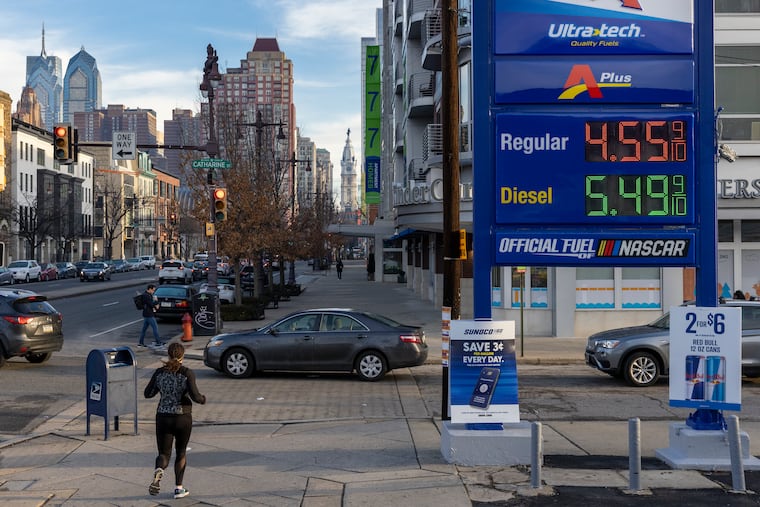
After dramatic increases following the Russian invasion of Ukraine, fuel prices in the Philadelphia area appear to have taken a breather this weekend, dropping a penny a gallon in Southeastern Pennsylvania and 4 cents in South Jersey.
The average price of a gallon of unleaded gasoline in Southeastern Pennsylvania was $4.47 on Saturday, down 1 cent from Friday. The price was up 73 cents from a month ago and up $1.48 from a year ago, according to AAA.
In South Jersey, the average price was $4.26 a gallon, down 4 cents from Friday. The price was up 79 cents from a month ago and up $1.41 from a year ago. New Jersey charges 42.4 cents per gallon in motor fuel taxes, and Pennsylvania charges 57.6 cents, explaining some of the difference between the two states.
» READ MORE: Where to find cheap gas in Philadelphia
It was the second day of softening gasoline prices in the region after prices soared more than 30 cents per gallon earlier in the week, according to AAA. Nationwide, gasoline sold for an average of $4.33 a gallon Saturday, up $1.49 from a year ago.
Philadelphia-area diesel prices retreated slightly from all-time highs set on Friday, according to AAA.
The average price of a gallon of diesel in Southeastern Pennsylvania was down 2 cents to $5.35 on Saturday and down 7 cents to $5.07 in Camden, Burlington, and Gloucester Counties. (New Jersey charges 49.4 cents tax on a gallon of diesel, and Pennsylvania charges 74.1 cents per gallon, the highest diesel tax rate in the nation.)
The recent run-up of retail prices has sparked an outpouring of outrage from consumers on social media about gouging. Tom Kloza, the global head of energy analysis for the Oil Price Information Service, said that exploration companies and refiners are doing well, but small retailers do not necessarily benefit.
“The public believes gasoline retailers are doing remarkably well when prices are rising, but the reverse is true,” said Kloza. “Retailers have their big innings when wholesale prices crash.”
Most fuel marketers are pricing gasoline about 50 cents above the wholesale cost, but with market prices moving rapidly, the seven-day rolling average margin for retailers is about 30 cents a gallon, Kloza said. That doesn’t include delivery costs, which are increasing, and a station’s operating costs. Credit card fees alone amount to about 3%, or 12 cents a gallon.
A high-volume retailer, such as a Wawa, Sheetz, or Costco, will typically get multiple deliveries of gasoline every day, and so its retail price can virtually track the wholesale cost, Kloza said.
But a smaller retailer that sells about 90,000 gallons a month might get a delivery every three days. “If you’re a smaller retail and you timed your purchase wrong, as some did, you might have paid well over $4 a gallon for the delivery into your station,” said Kloza. “If you guessed right, you might have paid less than $3.50 a gallon.”
» READ MORE: 7 ways to spend less money on gas
Philadelphia fuel prices have more than doubled since bottoming out in April 2020 during the pandemic lockdown. They increased steadily in the last half of 2020 and all of 2021 but skyrocketed since Russian’s Feb. 24 invasion of Ukraine. The markets were rattled by the prospect that energy flows would be disrupted from Russia, a major supplier of oil and gas, particularly to Europe.
Those concerns seem to have been fully priced into the market after President Joe Biden’s announcement on Tuesday ordering a ban on all imports of Russian crude oil and petroleum products into the United States in response to bipartisan calls in Congress. Russian imports make up a small percentage of U.S. oil and petroleum consumption.
The price for crude oil, the raw material in gasoline, peaked on Tuesday at nearly $124 a barrel before sinking in the following days. The price of a barrel of benchmark West Texas Intermediate crude closed at $109.09 a barrel on Friday, up $3 a barrel from the previous day but still 14% below its Tuesday peak, according to MarketWatch.
The U.S. Energy Information Administration on Wednesday forecast that crude oil prices would remain above $100 a barrel this year.